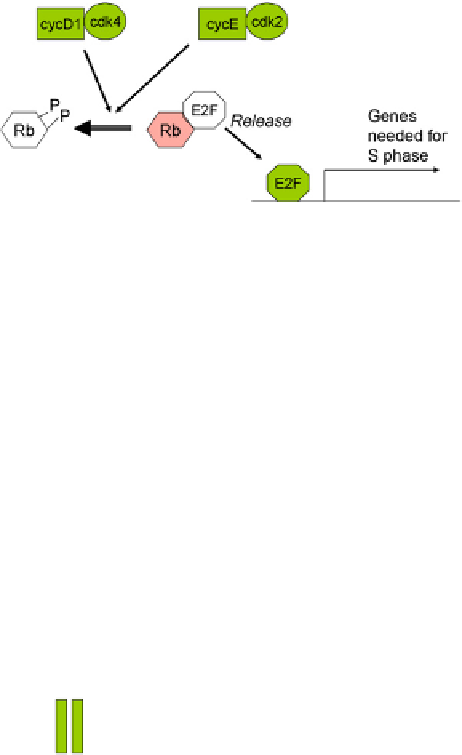Biology Reference
In-Depth Information
FIGURE 22.6
Rb normally blocks the transcription of genes needed for progress to S phase (cyclin A, dihy-
drofolate reductase, etc.) by inhibiting the activity of the transcription factor E2F. Phosphorylation of Rb renders it
incapable of inhibiting E2F, so the cell can progress. This diagram is based on information in Roovers and Assoian.
25
Positive regulators of cycle progression are shown in green and inhibitors in pink.
of how they are tied to positive and negative extracellular signalling will serve to illustrate
the general features of proliferation control.
Positive regulation of cell proliferation often uses the Erk MAP-kinase signal transduction
pathway, as the full name of this pathway, 'mitogen-activated protein kinase', suggests. Erk
MAP-kinase can be activated by a variety of pathways, but one of the most common proceeds
from receptor tyrosine kinases, via Grb2 and Sos, to activation of the small GTPase Ras by
exchanging the GDP of inactive Ras for the GTP of active Ras. Activated Ras then activates
Raf, which phosphorylates Mek, which in turn phosphorylates Erk (
Figure 22.7
). Once acti-
vated, Erk enters the nucleus and stimulates transcription of the fos and jun genes, the prod-
ucts of which combine to form the transcription regulator AP1. There is a consensus AP1 site
Growth factor
Ras
Ras*
RTK
Grb2
Sos
Raf
Mek
Erk
AP1
Fos
Cyclin D1
Jun
FIGURE 22.7
The connection (or at least, one of the connections) between growth factor signalling and cell cycle
regulation. The diagram is based on information in Ref. 25.





























